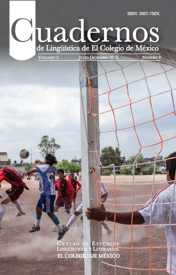Types of metonymic predications in nominal compounding in Mexican Spanish.
DOI:
https://doi.org/10.24201/clecm.v5i2.117Keywords:
metonymic compounds, exocentricity, compound-metonymy correlations, word formation, cognitive grammar.Abstract
In this paper, we analyze the external predications developed by some compound words in Spanish, commonly known as exocentric (Scalise & Guevara, 2006; Bauer, 2008). The main interest in this investigation is to uncover the nature of external predications; the concept of metonymy is used to achieve this goal. Based on previous research (Janda, 2011, Gutiérrez Rubio, 2014, Zacarías Ponce de León, 2015), we consider that external predication is a consequence of the use of these words to denominate entities from one of their prominent parts. The aim of this research is to establish a relationship between the class of compound and the selected types of metonymy. For this purpose, novel compound words from corpus Morfolex (2016) were analyzed in detail and sort regarding the external entities related, to find the preferred metonymic predications. It has been possible to identify correlations between different compositional structures and the types of metonymy selected.Downloads
References
Arcodia, Giorgio. 2012. Constructions and headedness in derivation and compounding. Morphology. 22. 365—397. DOI: https://doi.org/10.1007/s11525-011-9189-2
Barcelona, Antonio. 2008. The interaction of metonymy and metaphor in the meaning and form of ‘bahuvrihi’ compounds. Annual Review of Cognitive Linguistics. Vol. 6. 208—281. DOI: https://doi.org/10.1075/arcl.6.10bar
Barcelona, Antonio. 2011. Reviewing the properties and prototype structure of metonymy. En Benczes, Réka & Barcelona, Antonio & Ruiz CL de Mendoza, Francisco José (Eds.), Defining metonymy in cognitive linguistics. Towards a consensus view, 7—57. Ámsterdam/Filadelfia: John Benjamins. DOI: https://doi.org/10.1075/hcp.28.02bar
Barcelona, Antonio. 2012. La metonimia conceptual. En Ibarretxe-Antuñano, Iraide & Valenzuela, Javier (dirs.), Lingüística Cognitiva, 123—146. Barcelona: Anthropos.
Bauer, Laurie. 2008. Exocentric compounds. Morphology. 18. 51—74. DOI: https://doi.org/10.1007/s11525-008-9122-5
Bauer, Laurie. 2010. The typology of exocentric compounding. En Scalise, S. & Vogel, I (eds.), Cross-Disciplinary Issues in Compounding, 51—74. Ámsterdam/Filadelfia: John Benjamins. DOI. https://doi.org/10.1075/cilt.311.14bau
Bauer, Laurie. 2017. Compounds and compounding. Cambridge: Cambridge University Press. DOI: https://doi.org/10.1017/9781108235679
Benczes, Réka. 2006. Creative Compounding in English. Ámsterdam/Filadelfia: John Benjamins. DOI: https://doi.org/10.1075/hcp.19
Benveniste, Emile. 1977. Fundamentos sintácticos de la composición nominal. Problemas de lingüística general. Tomo 2. México: Siglo XXI.
Bloomfield, Leonard. 1933. Language. Nueva York: Holt.
Contreras, Heles. 1985. Spanish Exocentric Compounds. En Nuessel, Frank (ed.), Current Issues in Hispanic Phonology and Morphology, 14—26. Bloomington: iulc.
Coseriu, Eugenio 1978. La formación de palabras desde el punto de vista del contenido. Gramática, Semántica y Universales. Madrid: Gredos.
De Bustos Gisbert, Eugenio. 1986. La composición nominal en español. Salamanca: Universidad de Salamanca.
Gutiérrez Rubio, Enrique. 2014. Metonimia y derivación sufijal en español. Estudio multidimensional de los mecanismos conceptuales que rigen la formación de palabras mediante sufijación en español. Madrid: Liceus.
Janda, Laura. 2011. Metonymy in word-formation. Cognitive Linguistics. Vol. 22. No. 2. 359—392. DOI: https://doi.org/10.1515/cog-2014-0008
Kövecses, Zoltán, & Radden, Günter. 1998. Metonymy: Developing a cognitive linguistic view. Cognitive Linguistics. Vol. 9. No. 1. 37—77. DOI: https://doi.org/10.1515/cogl.1998.9.1.37
Kornfeld, Laura. 2009. Romance: Spanish. En Lieber, Rochelle & Štekauer, Pavol (eds.), The Oxford Handbook of Compounding, 436—452. Oxford/Nueva York: Oxford University Press. DOI: 10.1093/oxfordhb/9780199695720.013.0023
Lakoff, George. 1987. Women, Fire and Dangerous Things: What Categories Reveal About the Mind. Chicago: University of Chicago Press.
Lakoff, George, & Johnson, Mark. 1980. Metaphors We Live by. Chicago: University of Chicago Press.
Langacker, Ronald. 1999. Grammar and Conceptualization. Berlín: Mouton de Gruyter. Moyna, María Irene. 2012. Compound Words in Spanish. Theory and history. Ámsterdam/Filadelfia: John Benjamins Publishing Company. DOI: https://doi.org/10.1075/cilt.316
Peirsman, Yves & Geeraerts, Dirk. 2006. Metonymy as a prototypical category. Cognitive Linguistics. Vol. 17. No. 3. 269—316. DOI:https://doi.org/10.1515/COG.2006.007
Scalise, Sergio & Guevara, Emiliano. 2006. Exocentric Compounding in a Typological Framework. Lingue e Linguaggio. 2. 185—206. DOI:https://doi.org/10.1418/23143
Scalise, Sergio & Fábregas, Antonio. 2010. The head in compounding. En Scalise, Sergio & Vogel, Irene (eds.), Cross-Disciplinary Issues in Compounding, 109—125. Ámsterdam/Filadelfia: John Benjamins. DOI: https://doi.org/10.1075/cilt.311.10sca
Varela, Soledad. 1989. Spanish endocentric compounds and the ‘atom condition’. En Kirschner, Carl (Ed.), Studies in Romance Linguistics. 397—411. Ámsterdam: John Benjamins. DOI: https://doi.org/10.1075/cilt.60.24var
Williams, Edwin. 1981. On the notions ‘Lexically Related’ and ‘Head of a word’. Linguistic Inquiry. Vol. 12. 245—274.
Zacarías Ponce de León, Ramón Felipe. 2009. El espacio semántico de la composición nominal. México: UNAM. (Tesis de Doctorado).
Zacarías Ponce de León, Ramón Felipe. 2014. Flexión de número en la composición nominal del español: estructura morfológica y rutinización. Anuario de Letras. Lingüística y Filología. Vol. II, 2. 101—131. DOI: http://dx.doi.org/10.19130/iifl.adel.2.2.2014.79
Zacarías Ponce de León, Ramón Felipe. 2015. Compuestos metonímicos en español. ¿Exocentricidad o predicación de punto de referencia? Onomázein. 32. 62—79. DOI: https://doi.org/10.7764/onomazein.32.4
Zacarías Ponce de León, Ramón Felipe. 2016. “Morfología léxica en el español actual de México: Neología y productividad”, en Estudios de Lingüística aplicada, Año 34, Núm. 64. 11—31. DOI: https://doi.org/10.22201/enallt.01852647p.2016.64.687
Morfolex (2016). Morfolex. Estudio de la morfología y el léxico del español. https://sites.google.com/site/morfolex/ (Consultado: 21 de noviembre2015).
Downloads
Published
How to Cite
-
Abstract1680
-
PDF (Español)1149
-
XML (Español)643
Issue
Section
License
Authors retain copyright of their work and are free to disseminate it, make copies for any use, and/or deposit in any repository or archive of their choice, but they grant Cuadernos de Lingüística de El Colegio de México the right to publish the work for the first time. Authors agree to acknowledge Cuadernos de Lingüística de El Colegio de México as the site of original publication of their article / note / review through proper citation.
Articles appearing in Cuadernos de Lingüística de El Colegio de México are made available to readers under a Attribution-NonCommercial-NoDerivatives 4.0 International.









